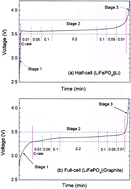A simple method for solving the voltage overshoots of LiFePO4-based lithium-ion batteries with different capacity classes
Abstract
To simulate the energy storage process of an energy harvesting device, a step-charging current protocol for LiFePO4-based lithium-ion batteries is considered, in which lower current rates are applied in both the earlier and latter steps of the voltage profile, while the maximum current (0.2 C-rate) is applied in the middle voltage region. The protocol is applied to three stages of voltage profile, i.e., initial step (stage 1), middle plateau (stage 2), and final step (stage 3) regions. In spite of their capacity-classes, lithium-ion batteries containing sub-μm-sized LiFePO4 have shown voltage overshoots in the step regions of the voltage profile, thus involving anomalous degradation of active materials and diminishing the stability and safety of the batteries. In order to overcome this overshoot problem, a simple method of blending a small amount of μm-sized LiCoO2 with the LiFePO4 is proposed. The results show that adding the LiCoO2 eliminates voltage overshoots. The small quantity of μm-sized LiCoO2 extends the operating voltage region as the short appearance of the LiCoO2 plateau serves to block the emergence of an overvoltage. In addition, battery performance is further improved by an increase in the electrode density brought about by the close packing of different-sized particles.


 Please wait while we load your content...
Please wait while we load your content...